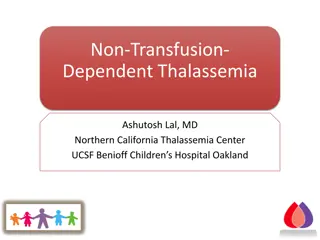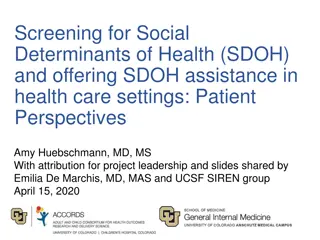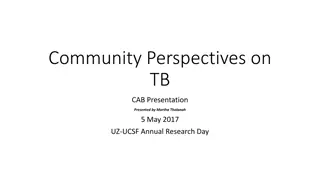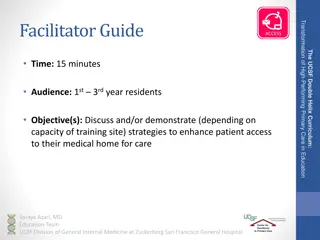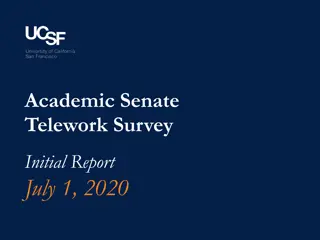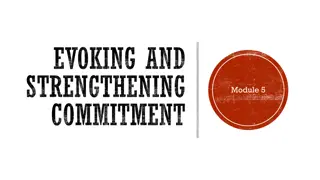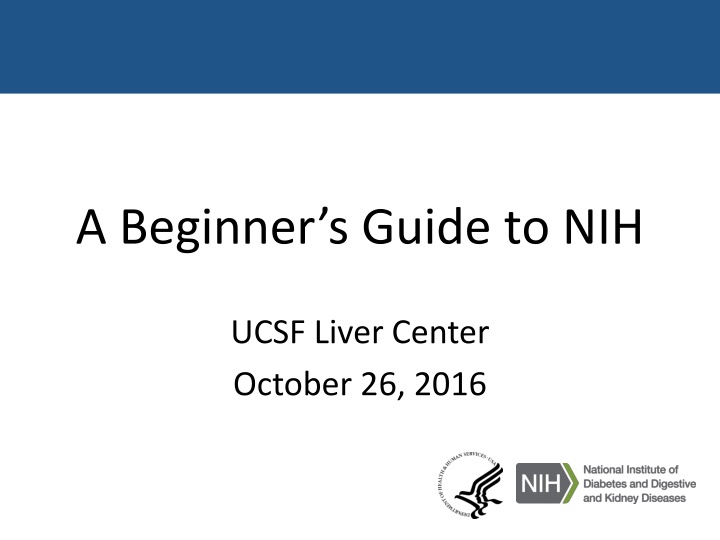
Comprehensive Guide to NIH and Biomedical Research Portfolio
Discover the National Institutes of Health (NIH), its mission, funding, and diverse research areas. Learn about the role of NIH in advancing healthcare through basic, translational, and clinical research. Explore the various institutes under NIH's umbrella and their contributions to understanding and treating diseases. Gain insights into preparing grant submissions, navigating funding opportunities, and maximizing the impact of your projects within the NIH ecosystem.
Download Presentation

Please find below an Image/Link to download the presentation.
The content on the website is provided AS IS for your information and personal use only. It may not be sold, licensed, or shared on other websites without obtaining consent from the author. If you encounter any issues during the download, it is possible that the publisher has removed the file from their server.
You are allowed to download the files provided on this website for personal or commercial use, subject to the condition that they are used lawfully. All files are the property of their respective owners.
The content on the website is provided AS IS for your information and personal use only. It may not be sold, licensed, or shared on other websites without obtaining consent from the author.
E N D
Presentation Transcript
A Beginners Guide to NIH UCSF Liver Center October 26, 2016
Understanding Elephants Sometimes you need a multidisciplinary team of zoologists How do I prepare my strongest submission? How should I move forward following my grant s review? Now that my project has been funded, what s next? Sometimes you need to consult a pachydermologist What opportunities are available to me at NIH? What is NIDDK Program looking for in a project? What is the current policy at NIDDK? Is it different at another NIH Institute? African vs. Asian specialists.
National Institutes of Health Much of the biomedical research in the United States is supported by the Federal government, primarily the National Institutes of Health (NIH) One agency of 10 within the U.S. Department of Health and Human Services (HHS) Comprises 27 Institutes and Centers (IC)
NIH Mission NIH s mission is to seek fundamental knowledge about the nature and behavior of living systems and the application of that knowledge to enhance health, lengthen life, and reduce illness and disability. (NIH supports basic and clinical research)
National Biomedical Research Portfolio Clinical Research Clinical Research Translational Research Translational Research Basic Research Basic Research NIH - $30B Private Sector - $59B
National Institutes of Health Office of the Director National Institute of Arthritis and Musculoskeletal and Skin Diseases National Institute of Child Health and Human Development National Institute on Alcohol Abuse and Alcoholism National Institute of Allergy and Infectious Diseases National Institute on Aging National Cancer Institute National Institute on Deafness and Other Communication Disorders National Institute of Dental and Craniofacial Research National Institute of Diabetes and Digestive and Kidney Diseases National Institute of Environmental Health Sciences National Institute on Drug Abuse National Eye Institute National Institute of Neurological Disorders and Stroke National Institute of General Medical Sciences National Heart, Lung, and Blood Institute National Human Genome Research Institute National Institute of Mental Health National Institute of Nursing Research National Institute of Biomedical Imaging and Bioengineering National Center for Complementary and Integrative Health National Center on Minority Health and Health Disparities Fogarty International Center National Center for Advancing Translational Sciences National Library of Medicine Center for Information Technology Center for Scientific Review Clinical Center
NIDDK Mission To conduct and support medical research and research training and to disseminate science-based information on diabetes and other endocrine and metabolic diseases; digestive diseases, nutritional disorders, and obesity; and kidney, urologic, and hematologic diseases, to improve people s health and quality of life
Core NIDDK Goals Principles Maintain a vigorous Investigator-initiated research portfolio Support pivotal clinical studies and trials Preserve a stable pool of talented new investigators Foster exceptional research training and mentoring opportunities Ensure knowledge dissemination through outreach and communications
FY 2016 Budget % 6.6 $2B NIH FY 2015 $30.31B* FY 2016 $32.31B* Total Prog. % NIDDK Total Prog. FY 2015 $1.899B* FY 2016 $1.968B* $69M 3.6*/4.0 *Includes Special Diabetes Program, $150M
NIDDK FY 2015 Budget by Mechanism RMS 4% FY15 Budget* $1,749,140 Intramural Research 10% R&D contracts 5% Research Training 3% Other Research 7% Research Project Grants 64% Research Centers 7% * Does not include Type 1 Diabetes Special Statutory Authority
How do we set the payline? Total budget 100 Centers 7 Training 3 Careers 5 Intramural 10 Non-competing renewals 54 Administrative overhead 4 Miscellaneous 2 Initiatives Contracts 5 Remainder 10 Payline
Pressures on the R01 Payline Trends in award costs Trends in application numbers Out-year commitments Noncompeting renewals
Trends in Award Cost Trends in Award Costs Cost per Grant Has Risen More than Total R01 Budget 19% increase 4% increase Median total costs of R01 grants Overall NIDDK Expenditures on R01s
Trends in Application Numbers Number of competing NIDDK R01 Applications 3000 ~2930 2777 2500 2510 2447 2378 2400 2331 2342 2293 2304 2251 2159 2000 R01 Applications 2008 1873 1806 1804 1756 1678 1722 1500 1613 26% increase 1574 1000 706 722 691 500 656 585 525 484 495 469 439 0 Total New Renewal
Can Reduce Pool Available for New Awards Outyear Commitments Total number of NIDDK R01/R37 Awards 2500 2307 2319 2293 2266 2242 2239 2133 2000 2007 2013 1955 1846 1813 1792 1786 1744 1779 1730 Awards (R01, R37) 1638 1570 1500 1473 1000 563 482 506 480 463 461 437 447 500 381 389 326 328 273 279 303 256 262 229 244 232 229 233 237 184 224 185 154 160 138 129 0 All funded Noncompeting All competing New Renewal
Life Cycle of a Grant New Directions Other Mechanisms Other Agencies/Foundations Receipt and Referral Renewal Application Study Section Initiates Research Idea Submits Application Institute Allocates Funds Advisory Councils & Boards Research Budgets Regulations Personnel Institute Director Institutional, Professional, and Personal responsibilities Available Resources
The Bottom Line: Overall Impact Impact: The likelihood of the research to exert a sustained, powerful influence on the particular research field. Translation for Reviewers: The first question to ask is How much do I care that this project is done? Then, depending on the answer, the next important questions is Can they do it?
Specific Aims Specific aims the yardstick by which success is measured How will progress in meeting the Specific Aims be measured? Publications, publications, publications Make sure they match the Approach (read your final application backwards) Hypotheses should be well articulated and accessible End with a cogent, compelling impact statement
Critiques: Review Criteria Aligned with application Significance Investigator(s) Innovation Approach Environment Human Subjects Protections and/or Humane Use and Care of Vertebrate Animals Biohazards as appropriate
Significance Charge to Reviewers Is there a strong scientific premise? Address whether the project advances its field, not whether the field is important. Does the project address an important problem or barrier to progress in its particular field? How much will the project improve knowledge, technical ability, or clinical practice? What they Look For A compelling premise for your project. If accomplished as presented, will and how the results have a substantial effect on the field. Seek out the panel that will appreciate the importance of your work.
Scientific Premise GOAL: Ensure that the underlying scientific foundation of the project concepts, previous work, and data (when relevant) is sound. Pertains to the underlying evidence/data for the project As an applicant you should: Provide sufficient justification for the proposed work Cite appropriate work and/or preliminary data Appropriately identified strengths and weaknesses in prior work in the field Proposes to fill a significant gap in the field OR explained why this is not possible? Important not to substitute hypothesis with premise - Addition to the review criteria (Significance): Is there a strong scientific premise?
Investigator(s) Charge to Reviewers Evaluate the PD/PI(s) ability to lead the project. Do not limit evaluation to the PD/PI(s), evaluate the collaborative team. Evaluate Multiple PD/PI leadership plan if applicable. What They Will Look For Overall productivity in the context of career stage. If a competing renewal, progress during the previous cycle. If a new application, productivity associated with any previous funding. Training and demonstrated expertise of the PI(s) Commitment of the team. The combined expertise of the team. Is the required skill set covered?
Investigator(s) The PI(s) don t need to have all of the expertise required for a project, they need to have the expertise to lead the project team. Recruit co-Investigators, etc. with recognized expertise. Biosketches: Personal statements should relate to your project and their role in it. Letters of Support: Should be related to your project and match your stated approach. Essential personnel should have a committed effort.
Innovation Charge to Reviewers Are the theoretical concepts, approaches, methodologies, instrumentation or interventions novel? How broadly applicable is the innovation? Is it confined to this field or broader? What They Look For Vertical versus horizontal science. Innovation can be conceptual and/or methodological. Note: Not all impactful projects are highly innovative.
Approach Charge to Reviewers Are there strategies to ensure a robust and unbiased approach, as appropriate for the work proposed? Is the research strategy well- reasoned and supported? Does it employ appropriate methods and analyses? Will the Aims address the hypothesis? Are expected results, alternative results, and potential pitfalls addressed? What They Look For Do the what and why make sense? Can the work be accomplished in the project period with the resources? Do the Aims/Subaims directly address the hypothesis/sub- hypothesis? Will they yield convincing data? Is/are the PI(s) considering limitations, important experimental variables, or the possibility of alternative results in the research approach?
Approach Communicate well. Don t assume what they know. Provide sufficient premise pilot data (take a critical approach to how you interpret it) and/or support from the literature (don t neglect contradictory papers) Realistic timelines Avoid being overly ambitious. Address the hypothesis directly. Focused and deep. Address limitations and the possibility of unanticipated results head on. Get input from collaborators.
Scientific Rigor GOAL: Ensure a strict application of scientific method that supports robust and unbiased design, analysis, interpretation, and reporting of results, and sufficient information for the study to be assessed and reproduced. Give careful consideration to the methods and issues that matter in your field. Pertains to the proposed research Address under Approach Possible considerations, if appropriate for the scientific field and research question, include plans for: determining group sizes analyzing anticipated results reducing bias ensuring independent and blinded measurements improving precision and reducing variability including or excluding research subjects managing missing data Addition to review criteria (Approach): Are there strategies to ensure a robust and unbiased approach, as appropriate for the work proposed?
Sex As a Biological Variable Consideration of sex, included under the umbrella of Relevant Biological Variables , is required in all studies involving human subjects or vertebrate animals. NIH expectations: As part of the Consideration of Relevant Biological Variables, applicants must provide adequate plans to address sex as a biological variable (for studies involving vertebrate animals or human subjects). If the study involves only one sex, is this justified scientifically? Reviewers will assess within the context of the research question and current scientific knowledge (Approach).
Environment Charge to Reviewers Assess the appropriateness of the resources, facilities and needs, and equipment for the particular project. Could also incorporate intellectual resources in the environment. What they Look For Are experts with intellectual and technical expertise readily available? Are the resources available? Institutional commitment to New PIs and ESIs. This includes Core facilities
Competitive Renewal Applications Competitive renewal (type 2) application is based on the outflow from the type 1 grant Were the aims completed? Is this documented (publications)? Is the research community familiar with the work? Is the work still interesting to the research field? Is it important? Does it contribute to a broad understanding of the field?
Additional Review Considerations Applications from Foreign Organizations Select Agent Research Resource Sharing Plans Budget and Period of Support Appropriateness of requested budget: personnel and supplies Potential overlap with other projects Additional Comments to Applicant Explicit reviewer guidance to applicants (optional)
Resource Authentication Attachment GOAL: Ensure processes are in place to identify and regularly validate key resources used in their research and avoid unreliable research as a result of misidentified or contaminated resources. Researchers are expected to authenticate key biological and/or chemical resources used in their research, to ensure that the resources are genuine. New Additional Review Consideration Authentication of Key Biological and/or Chemical Resources: For projects involving key biological and/or chemical resources, reviewers will comment on the brief plans proposed for identifying and ensuring the validity of those resources.
Impact/Priority Score The result of all panel members. If assigned reviewers disagree, the Impact/Priority score will indicate which argument held the most sway. This should be reflected in the Resume and Summary of Discussion No single reviewer is responsible for the outcome. It is a group decision.
Percentile Indicates the project s ranking within the group. More informative than raw Priority/Impact Scores. For standing Study Sections, the percentile base consists of R01s reviewed by that panel (current round plus the previous two). A score of 30 might rank 10th percentile in Study Section A and 20th percentile in Study Section B. For Special Emphasis Panels (SEPs), the base consists of three rounds of all R01s reviewed at CSR. Not all applications are percentiled (Ex: PARs, RFAs, R21s).
Resume and Summary of Discussion Prepared by SRO after the meeting Critiques, on the other hand, may or may not be edited after the discussion. Elements: Brief synopsis of proposed project Impact and significance (from the panel s perspective) Most important ( score driving ) strengths and weaknesses Additional issues raised during the discussion that are not described in critiques Differences in opinion and if/how they were resolved Conclusion
Critiques: Criterion Scores Do not over-interpret Provided before the meeting Criterion scores do NOT: Average out to be the overall score Always reflect the final score Undergo discussion at the meeting Criterion scores might: Provide a guide for which criteria were stronger and which were weaker
Contact your Program Officer POs may be able to provide guidance on: The likelihood of NIH funding the application Further discussion of the reviewers comments (if the PO was present at the review) Whether to submit a new or resubmission application What to address in your next submission The acceptable bases for appealing the peer review process
To Resubmit or Not? In most cases, it is advantageous to revise and resubmit your application and request assignment to the same study section Was the application reviewed in the right study section? Did the reviewers' expertise fit your topic? Were they knowledgeable about your methods? Did they understand the rationale for your research?
Acknowledge Your Centers Contribution in Presentations & on Posters If the DDRCC was used for the studies, acknowledge the Center by grant number (ex: P30DK000000) Consider briefly mentioning what services you used If funded through a P& F award, list it
Rigor and Transparency NIH Notice NOT-OD-16-011 discusses how both application instructions and review language have been updated for most research grant applications. NOT-OD-16-181 addresses the new FORMS-D application forms and instructions. NOT-OD-16-012 provides guidance for Career Development Awards. NOT-OD-16-034 provides guidance for Institutional Training Grants, Institutional Career Development Awards, and Individual Fellowships. NOT-OD-16-031 provides guidance for RPRRs (progress reports). NIH s Office of Extramural Research has established a website to assist PIs with this requirement.
Useful information: Be in the know! NIDDK Webpage NIH Guide https://grants.nih.gov/funding/about- nih-guide-to-grants-and-contracts.htm NIH Office of Extramural Research http://grants.nih.gov/grants/oer.htm


